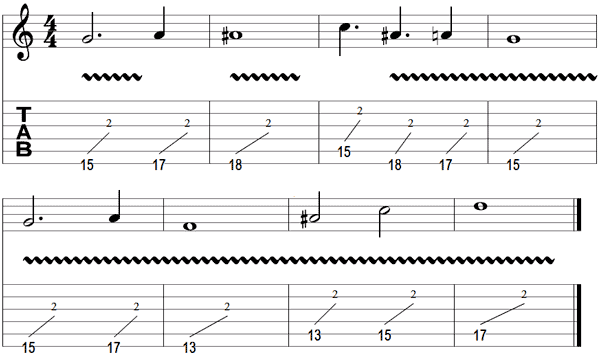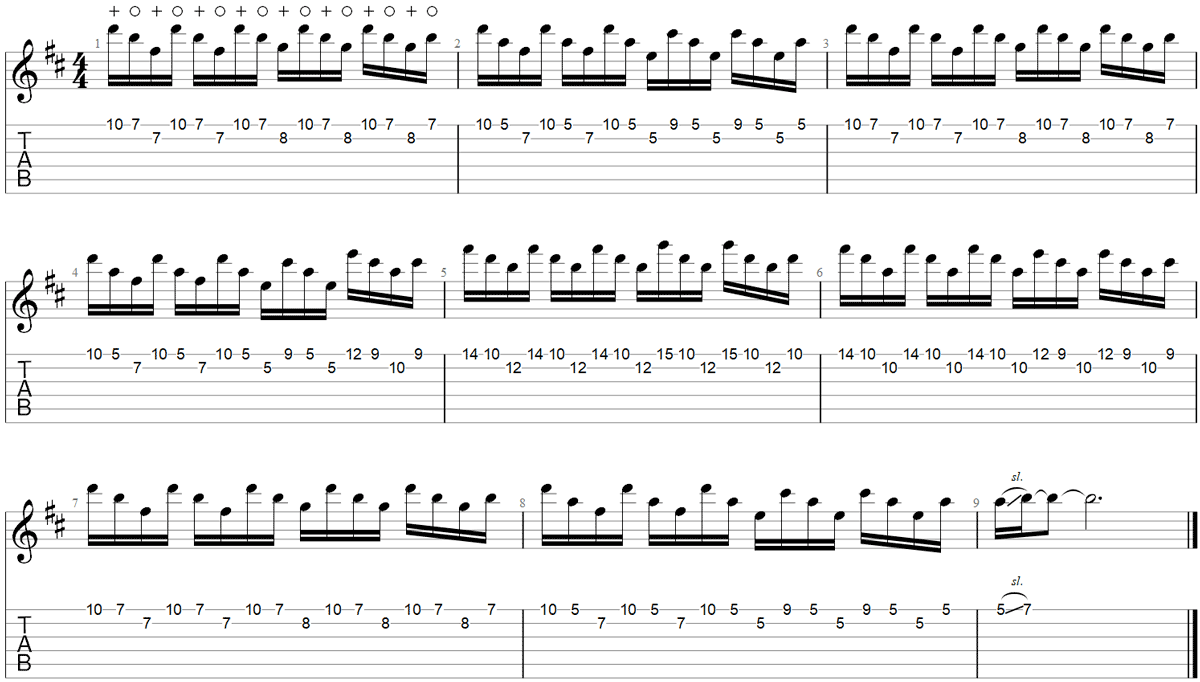The Whammy Pedal (a pitch shifter and harmonizer) is an iconic guitar effect that can give you a lot of inspiration when songwriting or jamming. Being able to shift your pitch at will, create a harmony or even simulate tuning your guitar down gives you so much freedom in your playing.
If you’ve bought a Whammy pedal and are looking at how to use it, start out with this lesson on Whammy pedal exercises. After you feel comfortable with those exercises, check out the songs in this list.

If you’re thinking about getting a whammy pedal but aren’t sure how much use you’ll get out of it, the songs in this list give you a good idea on the different type of things you can do with one. Check out this review on the DigiTech Whammy DT for a rundown of one of the best whammy pedals available.
Like a Stone – Audioslave
This is probably one of the more obvious examples of a whammy pedal in action. The solo in this song is a great example of how effective the whammy pedal can be in turning a simple melody into something incredible.
While I’ve included the TAB below, the whammy pedal lesson here explains how to play this solo so check it out to learn more.
Here is the first half of the solo in Guitar TAB format:

The lines with the ‘2’ above is notation for the whammy pedal (this is technically tremolo arm notation because Guitar Pro doesn’t have specific whammy pedal notation). What this means is that every time you see that line, you rock the whammy pedal forward so it shifts the pitch up two octaves.
If your whammy pedal doesn’t have the option to shift up two octaves (some multi-effect pitch shifters don’t have this option), set it for one octave up. It won’t sound the same as the song, but it will still sound similar.
Work on rocking the whammy pedal forward in a smooth and controlled way. You really want these notes to smoothly glide up in pitch. Adding delay as you can hear in the song also helps smooth the pitch change out.
Other Audioslave songs using the whammy pedal include Revelations, Cochise & The Worm. Find out more about Tom Morello and his Audioslave rig here.
Searching – Joe Satriani
This song uses the whammy pedal to give the song a very distinct sound. Rapidly moving the whammy pedal back and forth is pretty common, but the rhythmic movement tied into the playing is what makes this part sound so good.
In the below Guitar TAB, I’ve used wah pedal notation to indicate when the whammy is pushed back and forth. I’ve only included it in the first bar, but it’s the same pattern throughout.
The + means to rock the whammy to the toe position and the O is to rock it back to the heel position.

When you first try to play this part with the whammy, you may or may not find it difficult to coordinate your foot to your hands. I remember the first time I tried it back when the album came out and finding myself getting tripped up in the rhythm.
The whammy rocks back and forth eight times per bar. While this is happening, you’re playing a part that focuses on groups of three notes repeated over and over. So your foot is thinking “one two one two” while your hands are thinking “one two three one two three”.
If this is the first time you’ve tried something like this, it may feel challenging. But with some slow practice, you’ll quickly adapt and find it easy. Practice the part without the whammy until you’ve completely memorized it and can play it without thinking. Then when you add the whammy back in, you’ll have less to think about.
Try playing this part over a B Minor backing track and use it as the starting point for an extended jam. That’s basically what Searching is – an extended jam.
If you’re looking at trying to copy Joe’s tone or to jam along with his songs, read through my Ultimate Guide on Joe Satriani here.
The Blue – David Gilmour
David Gilmour uses a whammy pedal to produce very slow and smooth glides during the solo. It’s a great example of a more subtle use of the whammy that almost sounds like very wide bends.
The live version in the below video allows you to easily see when he’s using the Whammy as his hands stay still. You’ll notice he likes to play a bend, hold it, then slowly glide the whammy up while holding that bend.
The solo starts at 3:07 and you’ll hear the whammy in action almost straight away.
https://www.youtube.com/watch?v=rnjCW33A0SQ
A lot of the solo in the above live version is improvised, which I highly recommend experimenting with. Load up a backing track in a key you feel comfortable with and try to add slow glides similar to what you hear in the above solo.
Play around with lots of slow bends and try to blur the lines between what sounds like a bend and what sounds like the whammy. That’s what makes this song so interesting – he’s using different techniques to make the entire solo sound very smooth and silky.
Another great example of how David Gilmour uses the whammy pedal is in Marooned by Pink Floyd.
Know Your Enemy – Rage Against The Machine
Tom Morello used a whammy pedal in quite a few RATM songs. Know Your Enemy is a great example of using the whammy pedal’s harmony mode rather than the pitch shifting mode most people think of when they think of a whammy pedal.
The whammy is combined with the use of a toggle killswitch to produce a very unique staccato style of playing. Find out more on how he produced this sound in this guide on Tom Morello.
The below TAB shows what to play for this part:

It’s a very simple part to play and if you play it without the whammy or kill-switch, it will sound plain. This is a great example of how effects and pedals can inspire your playing.
Set your whammy pedal to harmony mode and try to use your ears to figure out what setting is the right one. Go through each setting (eg: up a third, fourth, fifth, etc.) and listen to how the part sounds. This is a great way to train your ears to identify different intervals.
As mentioned above, your Whammy pedal can be set to different intervals to produce completely different sounds. The more you understand the intervals you can choose on your Whammy, the more you’ll be able to make use of each setting.
Learn the basics of guitar intervals in this lesson. The lesson walks you through the basics of intervals and explains each type of interval. Once you read through that lesson (there’s also a video), you’ll have a better understanding of how to use the interval settings on your Whammy pedal.
The idea here is that you leave your whammy pedal in the toe position throughout the entire part. Unlike the other whammy pedal parts in these songs, this one doesn’t need you to move it at all. The whammy is only used to set the harmony.
Kill-switch or tremolo pedal
If you don’t have a kill-switch, you can use a tremolo pedal to replicate the effect almost perfectly. This song is at 80bpm, so adjust your tremolo pedal to match the song’s tempo.
You want the tremolo pedal to cut in and out hard once per note. Depending on your tremolo pedal, you may need to dial this in by guessing, or you may need to enter an exact time in milliseconds. If you need to use ms to set your tremolo effect, use this Guide to Convert BPM to MS (also handy for setting delay pedals).
If you’re interested in getting a tremolo pedal or learning more about the effect, check out my Guide on Tremolo Pedals.
Two other RATM songs using the whammy pedal worth checking out are Killing in the Name Of and Guerrilla Radio. Both use the whammy in very different ways.
Becoming – Pantera
This song uses the whammy more to produce noise rather than melodically like the other songs. During the riff in the beginning you’ll hear a high pitched squeal.
This is a great example of using a whammy in a rhythm section rather than lead. Have a listen to the song and see if you can come up with other ways of using a whammy in rhythm parts.
This is a really simple part to learn compared to the other songs:

The whammy is only used on the upper fourth fret in the riff. You may have a couple of ways to achieve this depending on the type of whammy pedal you have.
The standard way is to quickly rock the whammy pedal back and forth on that fourth fret note. With a bit of practice, you’ll be able to quickly rock it back in time to continue the riff in normal pitch.
Some whammy pedals such as the Whammy DT or the DigiTech Richochet have a ‘momentary switch’. When you hold this switch down, it produces an effect as if the whammy pedal was quickly rocked to the toe position. Then when you release the switch, it returns to normal pitch.
This type of riff shows how useful momentary switches can be. They allow you to come up with really interesting riffs like this one that quickly jumps between extreme pitch ranges. If you have a momentary switch, experiment with coming up with riffs like this one.
Touching Tongues – Steve Vai
Combining a whammy pedal with a long delay produces a really interesting sound as heard in this song. Steve Vai uses a lot of pitch based effects and depending on the type of pedal you buy you may be able to play almost all of the pitch effects from his songs.
While there are quite a few parts that use the whammy pedal in this song, here is the main melody that makes great use of it:

Pay very close attention to the + and O symbols in this TAB. The timing of the pedal plays a huge role in getting this part to sound right. If your timing is off, the melody won’t flow properly.
When you play this part without the whammy pedal, it sounds fairly plain. The whammy pedal steps this part up by gliding up and down an octave above normal.
A delay pedal is also used on this song to create an interesting harmony. Set your delay pedal to one beat behind and sync it up to the song’s tempo of 72 bpm. Remember, if you need to work out the exact delay time in milliseconds, use this guide.
Set your delay pedal to produce one repetition at a fairly high level. This creates a great harmony without things getting muddled.
Other examples of Steve Vai’s use of the whammy pedal include The Blood and Tears and Weeping China Doll. There are plenty of other songs that use pitch effects that your whammy pedal may be able to create. Find out more about Steve Vai’s rig and effects in this guide.
Seven Nation Army – The White Stripes
This song is an example of how you can use a Whammy pedal to mimic a bass guitar. The bass sounding instrument you hear in this song is actually a guitar with a whammy pedal shifting the pitch down an octave.
Even if you aren’t interested in playing music like this, being able to emulate a bass guitar can be really handy when writing songs and riffs.
The whammy pedal can let you hear how your ideas would sound on a bass guitar without needing to own one.
I won’t include the TAB for this song because it’s so simple you should be able to figure it out by ear (even if you’re a beginner). All you need to do is set your whammy pedal to an octave lower than normal and leave the pedal in that position.
Use a clean tone and try to dial your amp in to make it sound like a bass guitar. While it will never sound exactly like a real bass guitar, it’s close enough. You can then use this setting to play around with bass guitar parts in other songs. Try learning the bass parts of songs you already know to strengthen your understanding of the songs.
Setting a whammy pedal to an octave lower gives you the opportunity to learn a few well-known bass guitar parts. If you’ve never taken a look at bass parts before, it’s a great chance to learn something new.
Another White Stripes song using the whammy pedal worth checking out is Blue Orchid.
Get the most out of your whammy pedal
Understanding how pitch based effects interact with other effects can help you come up with new ideas and develop a better tone. In the Guitar Effects Course, you can learn more about pitch based effects as well as how to combine them with other effects. The course also explains how to position any pitch based pedals in your rig to get the best sounds out of them.
